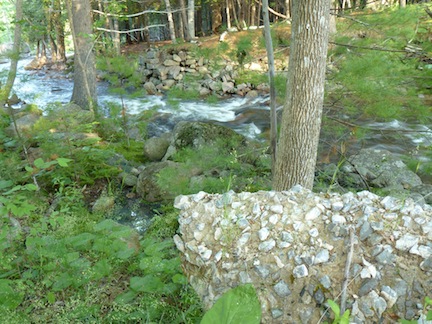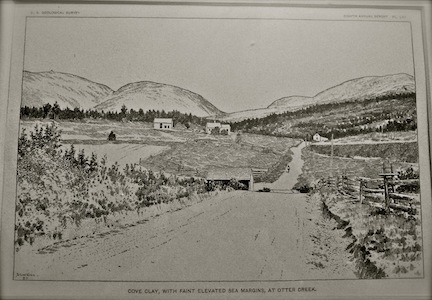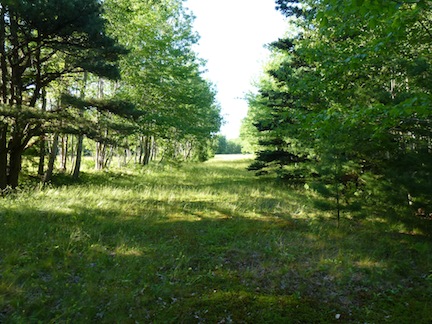Dorr Mountain, Cadillac, and Champlain–these are the mountains that surround the island village of Otter Creek. Their namesakes were men of power and position. George B. Dorr was the founder of Acadia National Park. Antoine Laumet de La Mothe, Sieur de Cadillac was a French explorer who once held title to all of Mount Desert Island and founded Detroit. Cadillac cars were named after him. Samuel de Champlain landed in Otter Creek in 1604 and gave our island its name, Isles des Monts Desert. It was adventurers, movers and shakers, people who stepped out of a mundane life to explore new territory that we chose to name our mountains for. These mountains are my everyday view, sometimes red and orange with foliage, sometimes white with snow, but always the background of life in Otter Creek. They are ever-present but always out-of-arm’s-reach.
Closer than the mountains, right under our feet and beneath the wheels of our cars, are the hills of Otter Creek. My home sits on the top of Ben’s Hill and I drive up and down Marm Allen’s Hill every day on my way to work. No one seems to remember who Ben or Marm Allen were, or why they had hills named after them. Roads have been straightened, and some of our hills blasted and flattened. Marm Allen’s Hill on the old Bar Harbor road once went down to the brook that runs into Otter Creek, and then straight back up past the old Allen farm. Presumably Marm was one of those Allen’s. The first bridge at the bottom of this hill was built in the 1800’s just a few feet above the surface of the stream. Rocks from its footings can still be seen. The second bridge, wisely built a bit higher since snow melting in spring makes the stream roar, has also left traces. This bridge was still walkable in the late 1960’s, the timbers old but spanning the water. It, too, flooded every spring. Today there is just a culvert, with twenty to thirty feet of dirt piled above it, raising Marm Allen’s bottom, making her hill far more gentle and leaving the remains of the first two bridges far below.

The granite remains of the oldest bridge on Marm Allen’s Hill, with the concrete remains of the second bridge.
Marm did not found a city or get a car named after her, and Ben could have been a hobo, but they are as much a part of the geography of our small village as the renowned personalities our mountains are called after.
Corkscrew Hill was not named after anyone. The road up this hill started at the base of Ben’s Hill where a timber and stone bridge crossed Main Brook close to where it opens into the Creek. Tumbled granite blocks in the water show where it once stood. This bridge was abandoned in the 1920’s or 30’s but the timbers were still there until they washed away some time in the 1960’s. My husband’s father, Larry Smith, said that when it rained and Corkscrew Hill was slippery the Model T’s would go up the hill backwards in order to make it to the top. We have walked the old road bed, and while steep it does not seem to twist. Did the cars have to zig zag up like a corkscrew to get to the top, or, as a neighbor suggested, was a bottle of something uncorked for the long ride to the other side of the creek?
We have two other hills here in the village. Music Hill is to the northwest of the cemetery and Music Hill Lane is the road leading to it. Paul Richardson, whose family was one of the village’s first families, thinks this name is fairly recent. Clyde Carter, whose family has been here for at least a few generations, recalls various members of the Smith family who lived up there playing what he calls old time music, fiddles and squeezeboxes and homemade percussion. Music Hill is as quiet as its neighboring cemetery these days.
Our last hill is Esther’s Hill. This was the local name for the long descent towards Seal Harbor, and finally there is someone who remembers Esther. Her name was really Vashti Esther, but she preferred to be called Esther, or V. Esther. She also had a pond named after her, and I heard the bullfrogs singing there today as I biked by. Esther was married to Lawrence Maynard Smith’s brother Maurice. She and Maurice had four children, Shane, David, Maurice and Martha, and one of the boys shot and killed Maurice the elder in a hunting accident.
After the accident Esther had better things to do than be a mother, and Martha and was raised by her grandmother Nyra, who also lived in Otter Creek. Now Nyra sounds like someone to name a hill after. While she may not have selected her three husband’s for their names, they make lovely sequence. Her first husband was Tripp, her second was Trott and her third, with whom she spent the rest of her life, was Harold Gallup. Harold did not live up to his name however, as Nyra once told my mother-in-law. “I’m interested, but Harold isn’t.”
Although Nyra lived on the same hill as Esther, it is Esther’s Hill, not Tripp, Trott, and Gallup Hill. Martha says she is not positive her grandmother’s second husband really was Trott, but that is what the villagers said, and it might have been.
Our hills are less steep and curved than they were a hundred years ago, but even then they were not considered majestic enough to deserve the name of a worldly explorer. But Champlain Mountain, Ben’s Hill, Dorr Mountain, and Esther’s Hill, whether named for hobo or hero they are equally part of the landscape of life in Otter Creek.



